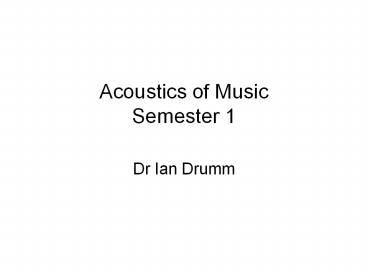Acoustics of Music Semester 1 - PowerPoint PPT Presentation
1 / 17
Title:
Acoustics of Music Semester 1
Description:
An introduction to Fourier Analysis and Synthesis Techniques. Learning Outcomes ... Essentially we summate the products of each signal element multiplied by the ... – PowerPoint PPT presentation
Number of Views:37
Avg rating:3.0/5.0
Title: Acoustics of Music Semester 1
1
Acoustics of MusicSemester 1
- Dr Ian Drumm
2
Waveforms
- Aims
- An introduction to Fourier Analysis and Synthesis
Techniques - Learning Outcomes
- Explain the mathematical basis for additive
synthesis - The study of complex musical timbres
- The synthesising of complex musical timbres from
simpler components
3
Fourier Series
- Linear Superimposition of Sinusoids to build
complex waveforms - If periodic (repeating)
Jean Baptiste Joseph Fourier 1768-1830
4
Fourier Series
- Decompose our complex periodic waveform into a
series of simple sinusoids - Where
5
Square Wave Example
- Consider
- Clearly period T2 hence ?p
- When we integrate we need to do so over sections
- t 0 to 1 and t1 to 2
6
- So to find series calculate coefficients a0,an
and bn
When evaluating an note the sin function is 0
when angle is every multiple of p
7
(No Transcript)
8
- Knowing
- We need to consider the cos function to determine
values of bn for n1,2,3,. etc
9
- We found coefficients to be
- Hence Fourier Series for a square wave is
10
- Lets try implementing series in Matlab
- We can see its not quite a square wave (Gibbs
phenomenon) given series should be infinite.
However with a for loop we can add more to the
series
f100 w2pif tlinspace(0,1/f5,100) y14/pi
(sin(wt)1/3sin(3wt)1/5sin(5wt)) plot(t,y
1)
To n10
To n1000
11
Saw tooth example
- Evaluating Fourier series for saw tooth produces
12
Triangle Example
- Evaluating Fourier series for triangle wave
13
Fourier Transforms
- The Fourier Transform
- The Inverse Fourier Transform
14
Discrete Fourier Transforms
- The Discrete Fourier Transform
- The Discrete Inverse Fourier Transform
15
Implementing a DFT
- Essentially we summate the products of each
signal element multiplied by the exponential term
for a given value of m - Hence using these sums we build a frequency
spectrum - Note each element in the new spectrum is a
complex number, so we need to find its magnitude
to plot
16
Applying DFT to earlier Square, Saw and Triangle
Series
xy1 nlength(y1) fRangesampleRate for
m0n-1 sum0 for k0n-1
sumsumx(k1)exp(-j2pimk/n) end
X(m1)1/nsum end fAxislinspace(0,fRange,n-1)
plot(fAxis(1n/2),abs(X(1n/2)))
Note this application is computationally
expensive hence the development of optimised
algorithms known as Fast Fourier Transforms (FFTs)
17
Partials
- Fourier series pertains to complex waveforms that
are periodic, being the summing of harmonics
f,2f,3f, etc - Real timbres quasi periodic thus yield
An-harmonic components. - Harmonic and An-harmonic components are
collectively referred to as partials - DFTs (and FFTs) can reveal an-harmonic content in
signals that arent periodic though a succession
of short time Fourier transforms is required to
faithfully capture their behaviour. - Given real musical notes are time varying
emulating partials is important for realistic
sounds































